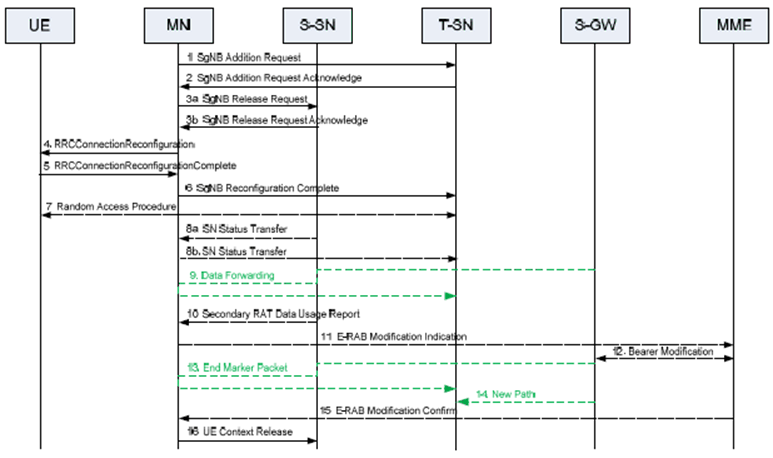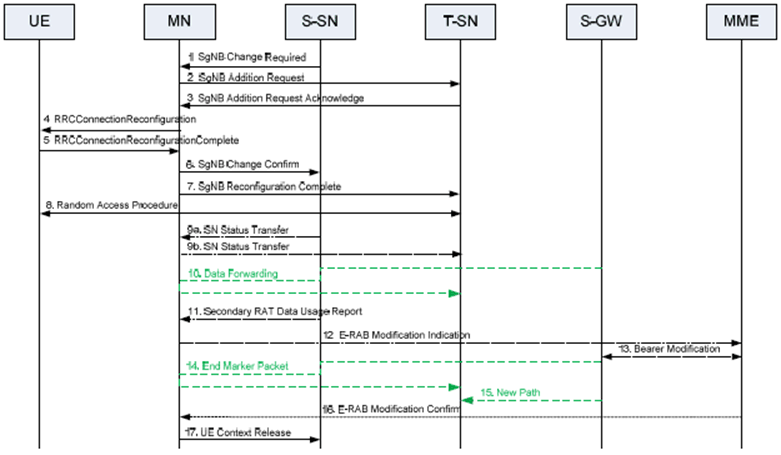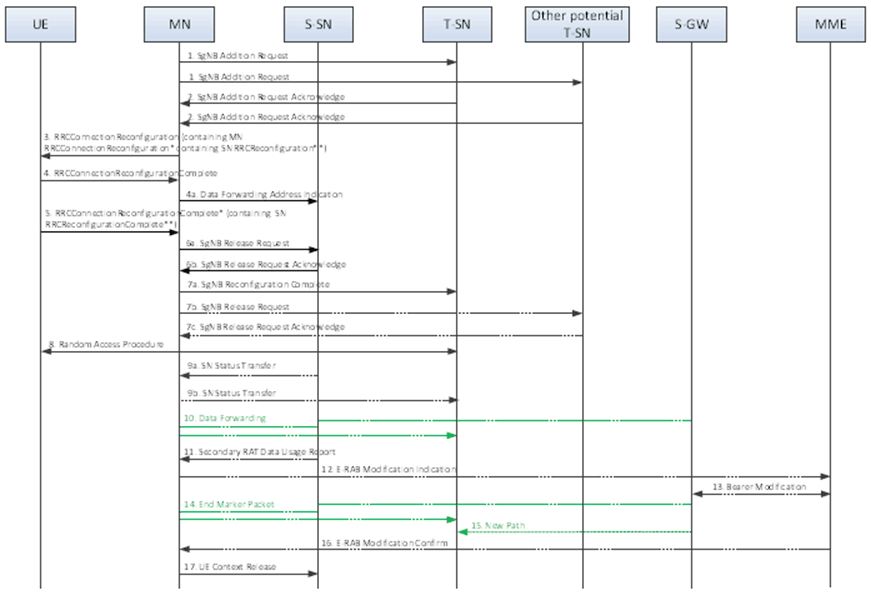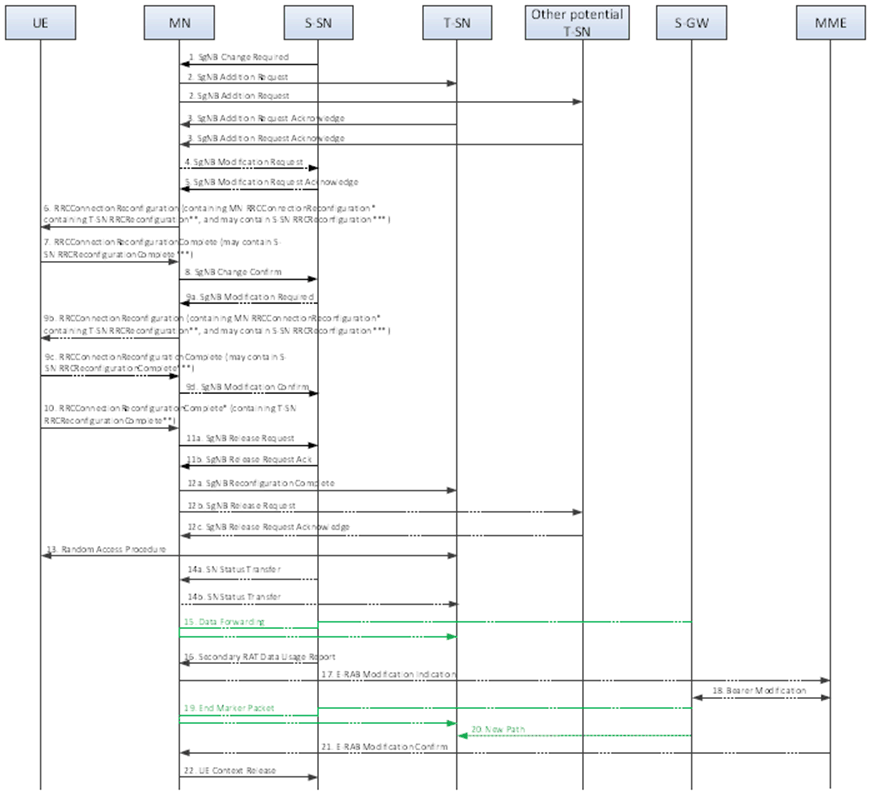Content for TS 37.340 Word version: 18.2.0
1…
4…
4.2…
4.3…
5…
7…
8…
9
10…
10.2…
10.2.2…
10.3…
10.3.2
10.4…
10.5…
10.5.2
10.6
10.7…
10.8…
10.9…
10.10…
10.11…
10.12…
10.12.2
10.13…
10.14…
10.15
10.16…
10.17…
10.18…
10.19…
10.20
11…
A
B…
10.5 Secondary Node Change (MN/SN initiated) p. 59
10.5.1 EN-DC p. 59
The Secondary Node Change procedure is initiated either by MN or SN and used to transfer a UE context from a source SN to a target SN and to change the SCG configuration in UE from one SN to another. In case of inter-SN CPC, the Conditional Secondary Node Change procedure initiated either by the MN or SN is also used for inter-SN CPC configuration and inter-SN CPC execution.
The Secondary Node Change procedure always involves signalling over MCG SRB towards the UE.
MN initiated SN Change

Figure 10.5.1-1 shows an example signalling flow for the MN initiated Secondary Node Change:
Step 1/2.
SN initiated SN Change
The MN initiates the SN change by requesting the target SN to allocate resources for the UE by means of the SgNB Addition procedure. The MN may include measurement results related to the target SN. If forwarding is needed, the target SN provides forwarding addresses to the MN. The target SN includes the indication of the full or delta RRC configuration.
Step 3.
If the allocation of target SN resources was successful, the MN initiates the release of the source SN resources including a Cause indicating SCG mobility. The Source SN may reject the release. If data forwarding is needed the MN provides data forwarding addresses to the source SN. If direct data forwarding is used for SN terminated bearers, the MN provides data forwarding addresses as received from the target SN to source SN. Reception of the SgNB Release Request message triggers the source SN to stop providing user data to the UE and, if applicable, to start data forwarding.
Step 4/5.
The MN triggers the UE to apply the new configuration. The MN indicates to the UE the new configuration in the RRCConnectionReconfiguration message including the NR RRC configuration message generated by the target SN. The UE applies the new configuration and sends the RRCConnectionReconfigurationComplete message, including the encoded NR RRC response message for the target SN, if needed. In case the UE is unable to comply with (part of) the configuration included in the RRCConnectionReconfiguration message, it performs the reconfiguration failure procedure.
Step 6.
If the RRC connection reconfiguration procedure was successful, the MN informs the target SN via SgNBReconfigurationComplete message with the encoded NR RRC response message for the target SN, if received from the UE.
Step 7.
If configured with bearers requiring SCG radio resources, the UE synchronizes to the target SN.
Step 8.
For SN terminated bearers using RLC AM, the source SN sends the SN Status Transfer message, which the MN sends then to the target SN, if needed.
Step 9.
If applicable, data forwarding from the source SN takes place. It may be initiated as early as the source SN receives the SgNB Release Request message from the MN.
Step 10.
The source SN sends the Secondary RAT Data Usage Report message to the MN and includes the data volumes delivered to and received from the UE over the NR radio for the related E-RABs.
Step 11-15.
If applicable, a path update is triggered by the MN.
Step 16.
Upon reception of the UE Context Release message, the source SN releases radio and C-plane related resources associated to the UE context. Any ongoing data forwarding may continue.

Figure 10.5.1-2 shows an example signalling flow for the Secondary Node Change initiated by the SN:
The MN initiated conditional inter-SN change procedure is used for inter-SN CPC configuration and inter-SN CPC execution.
Step 1.
MN initiated conditional SN Change
The source SN initiates the SN change procedure by sending SgNB Change Required message which contains target SN ID information and may include the SCG configuration (to support delta configuration) and measurement results related to the target SN.
Step 2/3.
The MN requests the target SN to allocate resources for the UE by means of the SgNB Addition procedure, including the measurement results related to the target SN received from the source SN. If forwarding is needed, the target SN provides forwarding addresses to the MN. The target SN includes the indication of the full or delta RRC configuration.
Step 4/5.
The MN triggers the UE to apply the new configuration. The MN indicates the new configuration to the UE in the RRCConnectionReconfiguration message including the NR RRC configuration message generated by the target SN. The UE applies the new configuration and sends the RRCConnectionReconfigurationComplete message, including the encoded NR RRC response message for the target SN, if needed. In case the UE is unable to comply with (part of) the configuration included in the RRCConnectionReconfiguration message, it performs the reconfiguration failure procedure.
Step 6.
If the allocation of target SN resources was successful, the MN confirms the release of the source SN resources. If data forwarding is needed the MN provides data forwarding addresses to the source SN. If direct data forwarding is used for SN terminated bearers, the MN provides data forwarding addresses as received from the target SN to source SN. Reception of the SgNB Change Confirm message triggers the source SN to stop providing user data to the UE and, if applicable, to start data forwarding.
Step 7.
If the RRC connection reconfiguration procedure was successful, the MN informs the target SN via SgNB Reconfiguration Complete message with the encoded NR RRC response message for the target SN, if received from the UE.
Step 8.
The UE synchronizes to the target SN.
Step 9.
For SN terminated bearers using RLC AM, the source SN sends the SN Status Transfer message, which the MN sends then to the target SN, if needed.
Step 10.
If applicable, data forwarding from the source SN takes place. It may be initiated as early as the source SN receives the SgNB Change Confirm message from the MN.
Step 11.
The source SN sends the Secondary RAT Data Usage Report message to the MN and includes the data volumes delivered to and received from the UE over the NR radio for the related E-RABs.
Step 12-16.
If applicable, a path update is triggered by the MN.
Step 17.
Upon reception of the UE Context Release message, the source SN releases radio and C-plane related resources associated to the UE context. Any ongoing data forwarding may continue.

Figure 10.5.1-3 shows an example signalling flow for the MN initiated Conditional Secondary Node Change:
The SN initiated conditional SN change procedure is used for inter-SN CPC configuration and inter-SN CPC execution.
The SN initiated conditional SN change procedure may also be initiated by the source SN, to modify the existing SN initiated inter-SN CPC configuration, or to trigger the release of the candidate SN by cancellation of all the prepared PSCells at the candidate SN and releasing the CPC related UE context at the candidate SN.
Step 1/2.
SN initiated conditional SN Change
The MN initiates the conditional SN change by requesting the candidate SN(s) to allocate resources for the UE by means of the SgNB Addition procedure, indicating that the request is for CPAC. The MN also provides the candidate cells recommended by MN via the latest measurement results for the candidate SN(s) to choose and configure the SCG cell(s), and provides the upper limit for the number of PSCells that can be prepared by the candidate SN. From the measurement results indicated by the MN, the candidate SN decides the list of PSCell(s) to prepare (considering the maximum number indicated by the MN) and, for each prepared PSCell, the candidate SN decides other SCG SCells and provides the new corresponding SCG radio resource configuration to the MN in an NR RRCReconfiguration** message contained in the SgNB Addition Request Acknowledge message with the prepared PSCell ID(s). If forwarding is needed, the candidate SN provides forwarding addresses to the MN. The candidate SN includes the indication of the full or delta RRC configuration. The candidate SN can either accept or reject each of the candidate cells listed within the measurement results indicated by the MN, i.e. it cannot configure any alternative candidates.
Step 3.
The MN sends to the UE an RRCConnectionReconfiguration message including the CPC configuration, i.e. a list of RRCConnectionReconfiguration* messages and associated execution conditions, in which each RRCConnectionReconfiguration* message contains the SCG configuration in the RRCReconfiguration** message received from the candidate SN in step 2 and possibly an MCG configuration. Besides, the RRCConnectionReconfiguration message can also include an updated MCG configuration, e.g., to configure the required conditional measurements.
Step 4.
The UE applies the RRCConnectionReconfiguration message received in step 3, stores the CPC configuration and replies to the MN with an RRCConnectionReconfigurationComplete message. In case the UE is unable to comply with (part of) the configuration included in the RRCConnectionReconfiguration message, it performs the reconfiguration failure procedure.
Step 4a.
Upon receiving the RRCConnectionReconfigurationComplete message from the UE, the MN triggers the Data Forwarding Address Indication procedure to the source SN to inform that the CPC has been configured, the source SN, if applicable, together with the Early Status Transfer procedure, starts early data forwarding. The PDCP SDU forwarding may take place during early data forwarding.
Step 5.
The UE starts evaluating the execution conditions. If the execution condition of one candidate PSCell is satisfied, the UE applies RRCConnectionReconfiguration* message corresponding to the selected candidate PSCell, and sends an RRCConnectionReconfigurationComplete* message, including an NR RRCReconfigurationComplete** message for the selected candidate PSCell, and information enabling the MN to identify the SN of the selected candidate PSCell.
Step 6a-6b.
The MN triggers the MeNB initiated SgNB Release procedure to inform the source SN to stop providing user data to the UE, and, if applicable, the address of the SN of the selected candidate PSCell to start data forwarding.
Step 7a-7c.
If the RRC connection reconfiguration procedure was successful, the MN informs the SN of the selected candidate PSCell via SgNB Reconfiguration Complete message, including the SN RRCReconfigurationComplete** message. The MN sends the SgNB Release Request message(s) to cancel CPC in the other candidate SN(s), if configured. The other candidate SN(s) acknowledges the release request.
Step 8.
The UE synchronizes to the PSCell indicated in the RRCConnectionReconfiguration* message applied in step 5.
Step 9a-9b.
For SN terminated bearers using RLC AM, the source SN sends the SN Status Transfer message, which the MN sends to the SN of the selected candidate PSCell, if needed.
Step 10.
If applicable, data forwarding from the source SN takes place. It may be initiated as early as the source SN receives the early data forwarding address in step 4a.
Step 11.
The source SN sends the Secondary RAT Data Usage Report message to the MN and includes the data volumes delivered to and received from the UE over the NR radio for the related E-RABs.
Step 12-16.
If applicable, a path update is triggered by the MN.
Step 17.
Upon reception of the UE Context Release message, the source SN releases radio and C-plane related resources associated to the UE context. Any ongoing data forwarding may continue.

Figure 10.5.1-4 shows an example signalling flow for the Conditional Secondary Node Change initiated by the SN:
Step 1.
The source SN initiates the conditional SN change procedure by sending SgNB Change Required message which contains a CPC initiation indication. The message also contains candidate SN ID(s) information and may include the SCG configuration (to support delta configuration), and contains the measurement results related to the candidate SN(s). The message also includes a list of proposed PSCell candidates recommended by the source SN, including execution conditions, the upper limit for the number of PSCells that can be prepared by each candidate SN, and may also include the SCG measurement configurations for CPC (e.g. measurement ID(s) to be used for CPC).
Step 2/3.
The MN requests each candidate SN to allocate resources for the UE by means of the SgNB Addition procedure(s) , indicating the request is for CPAC, and the measurements results related to the candidate SN and indicating a list of proposed PSCell candidates received from the source SN, but not including execution conditions. Within the list of PSCells suggested by the source SN, the candidate SN decides the list of PSCell(s) to prepare (considering the maximum number indicated by the MN) and, for each prepared PSCell, the candidate SN decides SCG SCells and provides the new corresponding SCG radio resource configuration to the MN in an NR RRCReconfiguration** message contained in the SgNB Addition Request Acknowledge message. If data forwarding is needed, the candidate SN provides data forwarding addresses to the MN. The candidate SN includes the indication of full or delta RRC configuration, and the list of prepared PSCell IDs to the MN. The candidate SN can either accept or reject each of the candidate cells suggested by the source SN, i.e. it cannot configure any alternative candidates.
Step 4/5.
The MN may indicate the candidate PSCells accepted by each candidate SN to the source SN via SgNB Modification Request message before it configures the UE e.g., when not all candidate PSCells were accepted by the candidate SN(s). If the MN does not send such indication, step 4 and 5 are skipped. If requested,the source SN sends an SgNB Modification Request Acknowledge message and if needed, provides an updated measurement configurations and/or the execution conditions for CPC to the MN.
Step 6.
The MN sends to the UE an RRCConnectionReconfiguration message including the CPC configuration, i.e. a list of RRCConnectionReconfiguration* messages and associated execution conditions, in which each RRCConnectionReconfiguration* message contains the SCG configuration in the RRCReconfiguration** message received from the candidate SN in step 3 and possibly an MCG configuration. Besides, the RRCConnectionReconfiguration message can also include an updated MCG configuration, as well as the NR RRCReconfiguration*** message generated by the source SN, e.g., to configure the required conditional measurements.
Step 7.
The UE applies the RRCConnectionReconfiguration message received in step 6, stores the CPC configuration and replies to the MN with an RRCConnectionReconfigurationComplete message, which can include an NR RRCReconfigurationComplete*** message. In case the UE is unable to comply with (part of) the configuration included in the RRCConnectionReconfiguration message, it performs the reconfiguration failure procedure.
Step 8.
If an NR RRC response message is included, the MN informs the source SN with the NR RRCReconfigurationComplete*** message via SgNB Change Confirm message. If step 4 and 5 are skipped, the MN will indicate the candidate PSCells accepted by each candidate SN to the source SN in the SgNB Change Confirm message.
The MN sends the SgNB Change Confirm message towards the source SN to indicate that CPC is prepared, and in such case the source SN continues providing user data to the UE. If early data forwarding is applied, the MN informs the source SN the data forwarding address(es), the source SN, if applicable, together with the Early Status Transfer procedure, starts early data forwarding. The PDCP SDU forwarding may take place during early data forwarding. In case multiple candidate SNs are prepared, the MN includes a list of Target SgNB ID and list of data forwarding addresses to the source SN.
Step 9a-9d.
The source SN may send the SgNB Modification Required message to trigger an update of CPC execution condition and/or corresponding SCG measurement configuration for CPC. In such case in step 9b, the MN reconfigures the UE and in step 9c the UE responds with RRCConnectionReconfigurationComplete, similarly as in steps 6 and 7.
Step 10.
The UE starts evaluating the execution conditions. If the execution condition of one candidate PSCell is satisfied, the UE applies the RRCConnectionReconfiguration* message corresponding to the selected candidate PSCell, and sends an RRCConnectionReconfigurationComplete* message, including the NR RRCReconfigurationComplete** message for the selected candidate PSCell, and information enabling the MN to identify the SN of the selected candidate PSCell.
Step 11a-11b.
The MN triggers the MeNB initiated SgNB Release procedure to inform source SN to stop providing user data to the UE, and if applicable, provides the address of the SN of the selected candidate PSCell to start late data forwarding.
Step 12a-12c.
If the RRC connection reconfiguration procedure was successful, the MN informs the SN of the selected candidate PSCell via SgNB Reconfiguration Complete message, including the SN RRCReconfigurationComplete** message. The MN sends the SgNB Release Request message(s) to cancel CPC in the other candidate SN(s), if configured. The other candidate SN(s) acknowledges the release request.
Step 13.
The UE synchronizes to the PSCell indicated in the RRCConnectionReconfiguration* message applied in step 10.
Step 14a-14b.
For SN terminated bearers using RLC AM, the source SN sends the SN Status Transfer message, which the MN sends then to the SN of the selected candidate PSCell, if needed.
Step 15.
If applicable, data forwarding from the source SN takes place. It may be initiated as early as the source SN receives the early data forwarding message from the MN.
Step 16.
The source SN sends the Secondary RAT Data Usage Report message to the MN and includes the data volumes delivered to and received from the UE over the NR radio for the related E-RABs.
Step 17-21.
If applicable, a path update is triggered by the MN.
Step 22.
Upon reception of the UE Context Release message, the source SN releases radio and C-plane related resources associated to the UE context. Any ongoing data forwarding may continue.